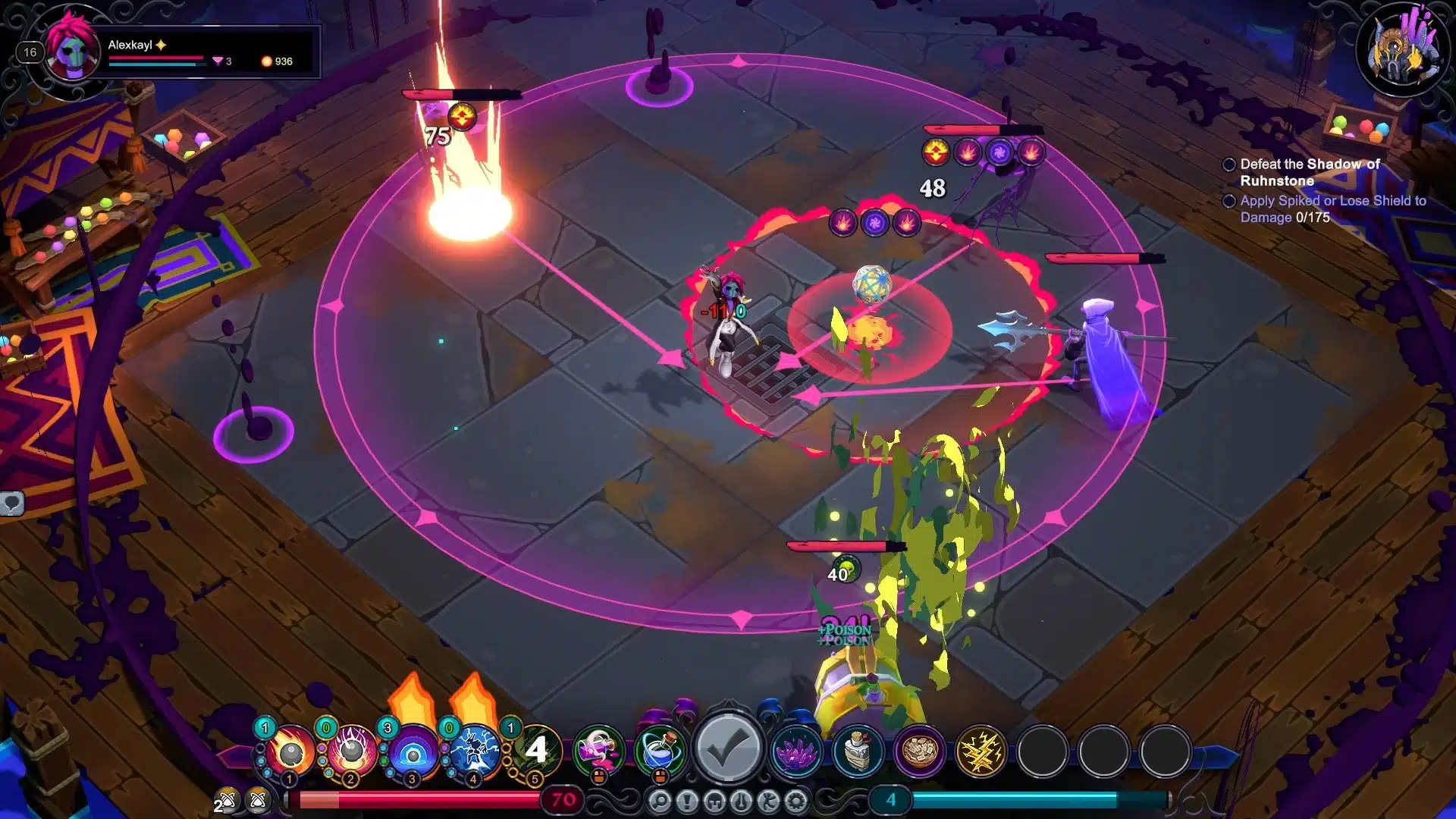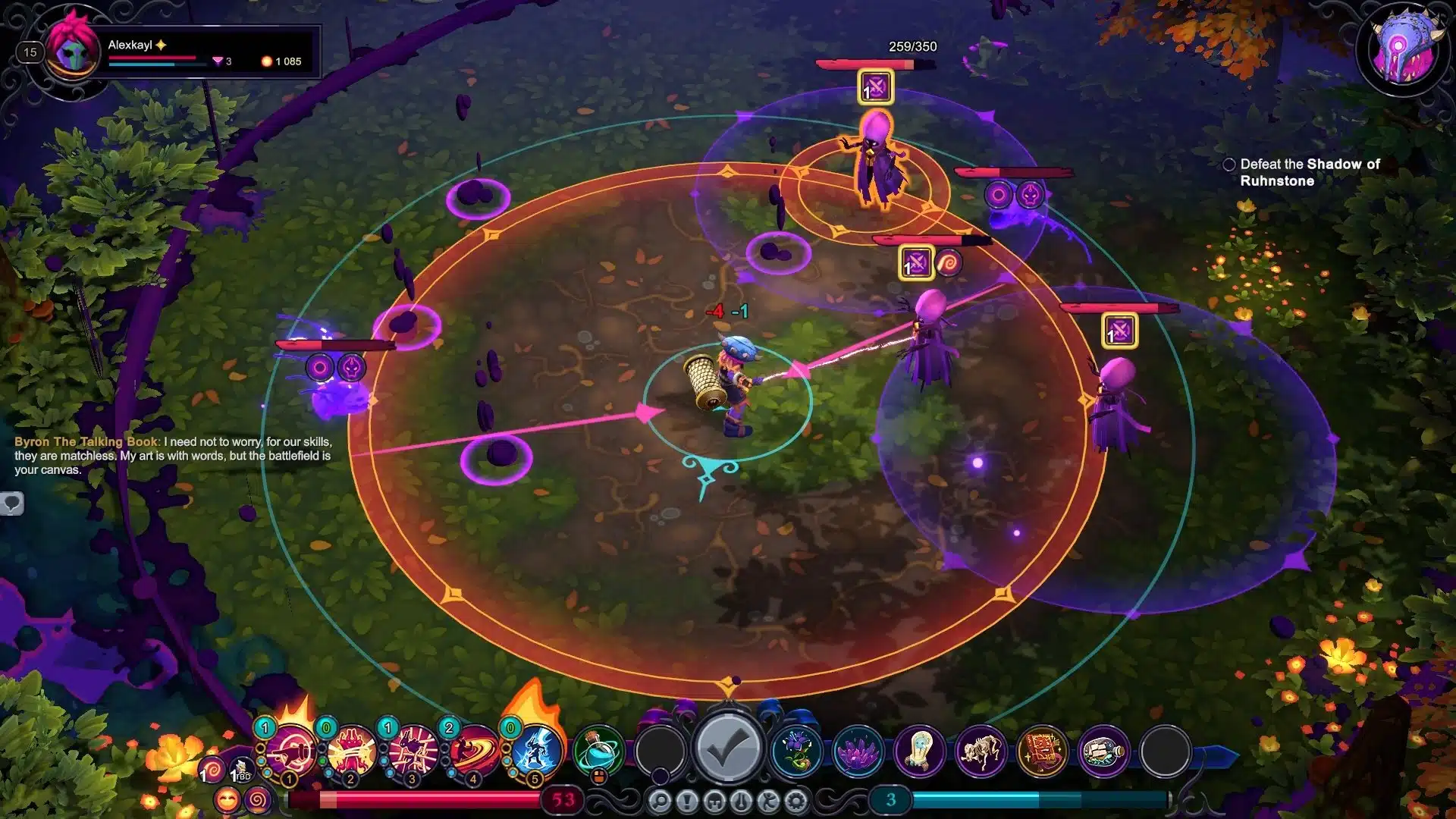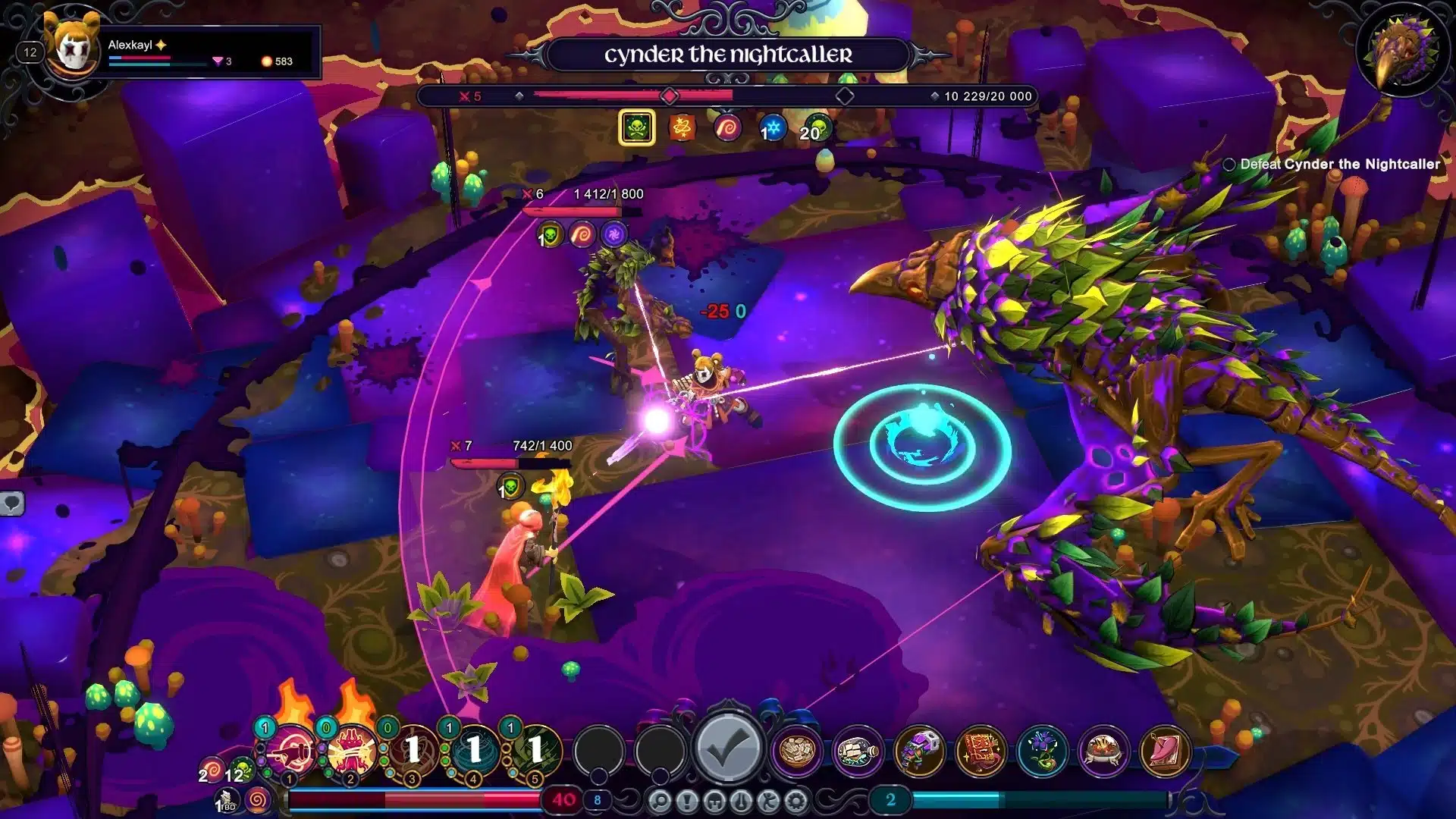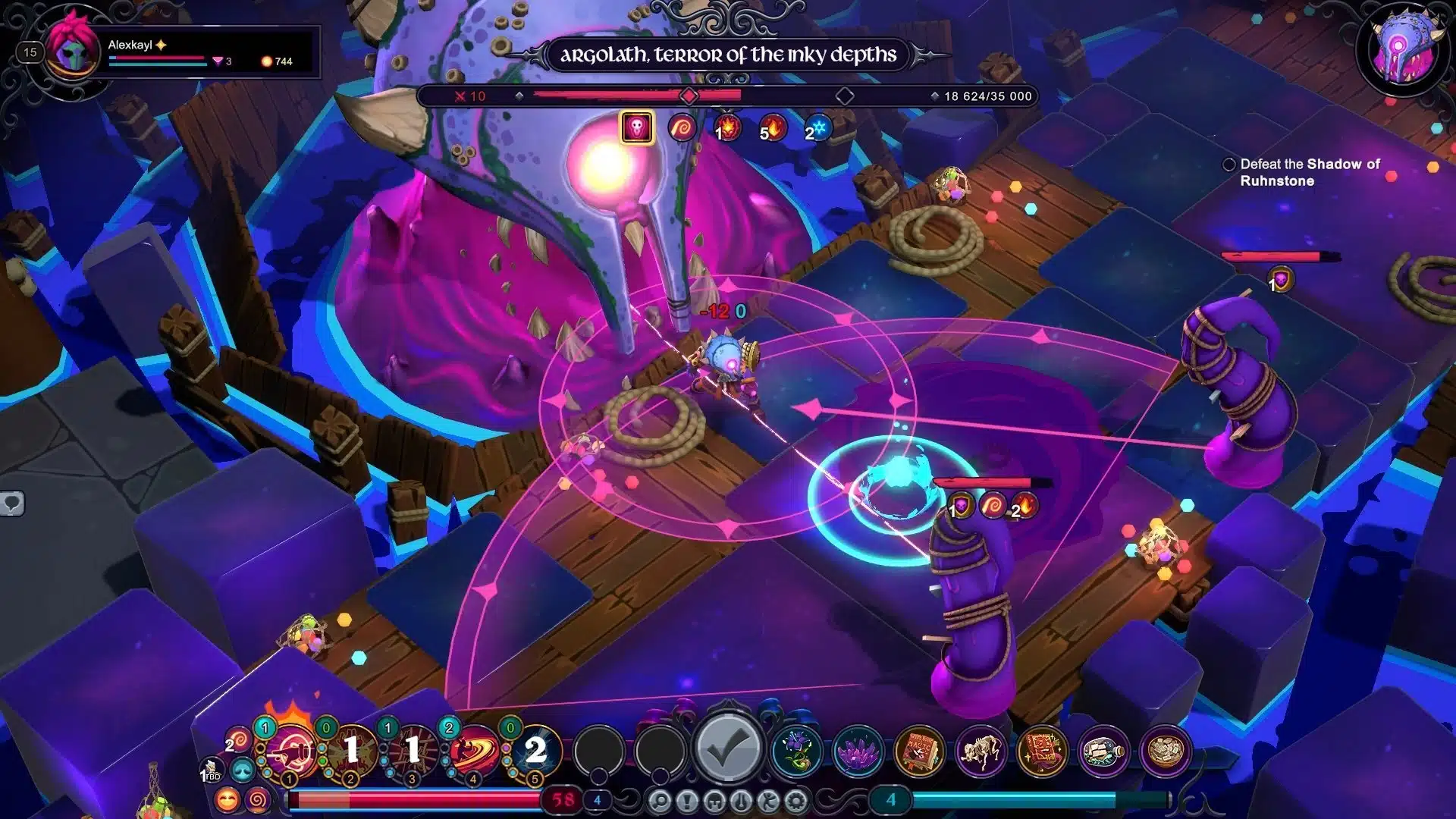Inkbound is a new turn-based roguelike from Shiny Shoe, makers of Monster Train, expanding on the mechanics of the hit deck building game. Turn-based at heart but throwing many perceptions of the genre out of the window and stomping on them, this whimsical tale into a world of books and stories under threat is an engrossing journey that fans of the genre will devour with gusto, one run at a time.
Turn the Page
Set within a world that is an acquired taste, you step into the shoes of a Needless, a being that will use the Atheneum Library books as portals to other worlds and strive to save them from the villains. The garish colors and fantastical characters, starting with the player avatar, are straight out of a universe that feels completely dreamlike and occasionally too eccentric, but it grows on you and becomes a wonderful experience with a wisely crafted setting that is seldom seen in videogames.
Thinking inside the book but out of the box is how the designers came up with the concept of turn-based battles for Inkbound. Your character has a mana pool – called Will – that serves both for movement and abilities – or Bindings –, but you can move freely in the arena until you delegate your actions. Reverting to your location before confirming any action returns the movement points to you, allowing for perfect spot judgment as you try to align a skillshot with various enemies.

You execute your actions in succession, ending your turn and giving room to the enemies to make their moves, one after the other. You can judge the damage output both from your attacks and your foes’, as every move is telegraphed, perfectly forecasting the outcome of the current turn, and encouraging you to carefully consider positioning, attack radius, and the toll they will take on your health bar. Forget to save a movement point for the end of turn and you may be greeted with a barrage of shots that could have been easily avoided. Power orbs frequently appear on the battlefield and can be true lifesavers as you struggle for additional movement points.
Inkbound is remarkable fun and brisk played solo, but it becomes even more engaging in cooperative mode for up to four players. The core gameplay system doesn’t change much, as you and your teammates simultaneously execute their actions, ending the turn to give the AI their shot. The class combinations and Binding variations are a great incentive to try all sorts of strategies and to marvel at some of the outcomes, such is the scope for teamplay.
A Smudge of Class

Inkbound comes with three starting classes and more to be unlocked via completing quests and defeating the striking villains, the bosses of this corrupted literature world. The creativity behind these Needless, as they are referred to by the mystical beings from the Atheneum Library and beyond, is nothing short of impressive.
These faceless creatures wildly vary in artistic design and base kit, showcasing terrific potential for experimentation and combination of the massive pool of Bindings and Vestiges, with results that can be extremely diverse after each run.
In a succinct description, here are the current classes: the Magma Miner is a hammer-wielding brute that deals additional damage; the Mosscloak is in tune with nature and akin to the stealth assassin template, also noticeable by the use of shuriken as weapon of choice; the Weaver is the most original of the bunch and my first favorite, an artisan Spider-Man of sorts with its use of magical threads to leash enemies and act as conduits for Bindings; the Obelisk is a tank carrying two massive stone shields that absorb damage, but also work as attack weapons; the Clairvoyant is a mage class with another ingenious twist, using a shardglobe to funnel her Bindings and create some devastating attacks.
Picking a class for the long run is a tough task, given the options and combos that we seem to discover with each new run. Take the Weaver as an example, as I reached a point where I had this incredible build with finely chosen Bindings and a largely unbeatable combination of Vestiges – relics that give you several buffs –, chaining impressive actions that barely gave the enemies room to breathe, let alone to take their turns.
No Rest for the Inked

Each run in Inkbound is comprised of straight choices that take you through a succession of events and battles, regularly placing you on branching paths. You start by selecting one of the three villains that you wish the face after completing the three books, each one set within a different biome.
With a look and feel inspired by the best top-down action RPGs and close to those “choose your own adventure” books, aesthetic included, the worlds are sadly entirely linear in their design, and this is the thing where the game could have aimed higher. The brilliant combat system is screaming for world building of the same level, one that would go beyond the basic – albeit beautiful – procedurally generated corridors and throw us into these fanciful lands prone for exploration and discovery, rewarding the most inquisitive and attentive players. Alas, there’s nothing of the sort.
Saying that you start from scratch after each run is an understatement. You don’t just restart with better knowledge on enemy types, events, and Bindings that you earn and upgrade at every turn; you unlock dozens of new Vestiges of different rarities that are true gamechangers, allowing you to experiment with builds that will take you one step closer to your goal. There are several quests to shoot for, increasing your season level and rewarding you with cosmetics aplenty. The hub is filled with quirky faces that act as quest givers, and functions as a place for seamless class changes and further character customization.
Inkbound should get plenty of additional content in the future, working as a live-service game with daily and seasonal quests alongside the standard missions, always with something motivating you to go for another run.
Nearly Ink-ridible

As with any intricate book, first impressions when entering the storybook tomes of Inkbound may not be immediately accessible or easy to absorb, but let all the dreamlike colors and mystical lore sink in, and it becomes a roguelike world you don’t want to leave so soon. Fun both in solo and cooperative play, Inkbound would be an even better game if the exploration stages were less constricting and offered us more room to explore, more places to discover on our own bidding; however, these worlds were penned for linear paths and feel very restrictive in their design.
There’s a certain addictive and wondrous factor in Inkbound that creeps in and may trigger your childhood imagination, enticing you to go for just another run, time after time. This is certainly related to the magical world, but also to the way you zoom across the maps, turn-based battles flowing in such an accessible way, inviting imaginative strategies and creative builds. Don’t turn the page on Inkbound – this is a book… I mean, a game that deserves to be savored for days on end.
Score: 8.5/10
Pros:
- Whimsical and inventive world that grows on you
- Creative turn-based battle system
- Original classes that play very differently
- Fun both in solo and cooperative modes
- Comes with that rare addictive factor
Cons:
- Biomes are disappointingly restrictive
Inkbound review code was provided by the publisher. You can read MP1st’s review and scoring policy right here.
